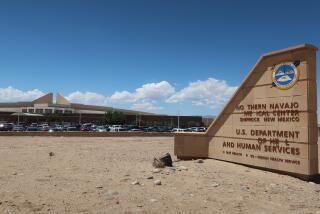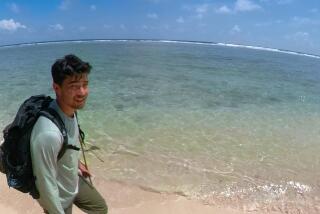Swept Into the World
- Share via
HUT BAY, India — Nine days after giant waves struck Little Andaman island, a child was born in a soccer stadium and the Onge tribe of hunters and gatherers took a step away from extinction.
The rain forest that surrounds the tribe, along with traditional Onge wisdom, saved it in a catastrophe that killed more than 150,000 people across southern Asia. Now some experts fear that the tsunami’s aftermath will prove more dangerous than the waves.
The Onge are one of five endangered hunter-gatherer tribes that have lived for tens of thousands of years in the forests of India’s far-flung Andaman and Nicobar Islands, where the pressures of modern development have threatened to wipe them out.
The birth of a girl, at a makeshift relief camp at the stadium, raised the Onge population to 97. Although the outside help that arrived after the tsunami may have improved the odds of survival for the anemic mother and her newborn, activists fighting to protect the archipelago’s indigenous people say the aid, including inappropriate shelter, food and clothing, is among several post-disaster shocks that have endangered the ancient societies.
“As far as the aboriginal tribes are concerned, they don’t need aid,” said environmentalist Samir Acharya, who runs the Society for Andaman and Nicobar Ecology in Port Blair, the Indian territory’s capital. “It’s a mindless thing to do. That’s how we’re spoiling them.”
The islands lie just a few hundred miles northwest of the epicenter of the Dec. 26 earthquake that triggered the tsunami. Yet none of an estimated 840 people in the five aboriginal tribes was injured when the waves struck, said Khitish Chandra Ghoshal, a tribal welfare official in Port Blair.
An elder of the Jarawa tribe led his people to safety on a hilltop after a boy’s sudden dizziness signaled the distant tremors that presaged the tsunami, Ghoshal said.
“The old man told them that when he was a child and these types of things happened, his father told him that he should follow this procedure if they happened again,” he said.
The Onge knew when the level of the creek running through their village suddenly dropped that it meant the sea was pulling back, preparing to strike like a fist. They, too, fled to the hills, as their ancestors had taught them.
Down the coast in Hut Bay, where settlers from India’s mainland took over tribal land decades ago, the waves killed at least 48 people.
After the disaster, government officials led most of the Onge tribe from its remote tribal reserve, one of several created by the government, to the soccer stadium, in a town five miles away. Anindo Majumdar, an official sent from New Delhi to coordinate the relief effort on Little Andaman, said the government gave aid to the Onge only when they asked for it.
The Onge camped out on the sports field for almost two weeks, along with homeless settlers. They were two worlds separated only by the chalk-white line marking center field. The settlers and the Onge ate the same rations of lentils, rice, cookies and mineral water, and received blankets, clothes and flip-flops.
Tribespeople found themselves surrounded by foreign ways, unable to choose when to be seen or heard, longing to return to the forest that sustained their spirits.
Experts on the tribes say the government’s help was the kind that could do more harm than good. They have become familiar with the risks through the archipelago’s history of intrusions, beginning with a British penal colony 150 years ago and, a decade later, the first logging of the islands’ hardwood.
For centuries, the rain forest was the Onge’s provider and protector. It fed them wild boar, hunted with poison-tipped arrows, as well as jackfruit and the honey of giant rock bees. The trees shielded them against time’s advance.
For decades, Indian governments sought to bring the tribes into what officials called the mainstream. Critics say the policy was intended to remove the tribal people and their reserves, as obstacles to logging.
When India opened a third of the Onge’s rain forest reserve to logging in the early 1970s, it also launched an ambitious effort to change thousands of years of Onge tradition.
Officials moved the tribe’s semi-nomadic people into two settlements and gave them houses with corrugated asbestos roofs. But the houses were not as cool in the tropical heat and humidity as their huts had been.
Welfare workers also taught the Onge the basics of Indian currency and encouraged them to work on palm oil plantations and use their earnings to buy goods from settlers in Hut Bay.
Many of the Onge now suffer from malnutrition because the rice, sugar, tea and other food rations they came to depend on replaced their traditional diet. Ailments such as anemia, tuberculosis and diarrhea have become endemic.
Outsiders passed on unhealthy habits such as smoking and drinking. Some raped Onge women or exploited them sexually, said Acharya and other experts who worry that the current relief effort may only make matters worse.
“We’ve seen what 30 years of intervention, in what started off as relief efforts, did to them,” said anthropologist Sita Venkateswar, a professor at New Zealand’s Massey University. “It was terrible for them.”
Andaman and Nicobar is an archipelago of nearly 600 tropical islands, islets and rocky outcroppings spread in an arc across 3,100 square miles of the Bay of Bengal.
Only 24 of the islands are inhabited. Most of the nearly 400,000 residents are settlers from the Indian subcontinent.
The tribes numbered several thousand at the turn of the 20th century, but their population has dropped steadily under the pressures of colonization, logging and tourism.
Although the tribal welfare system is slowly destroying the Onge’s traditional way of life, members still follow customs and beliefs that have been handed down over thousands of years.
They believe, for instance, that a woman becomes pregnant with the grace of a spirit that lives in the sky above Little Andaman. According to tradition, the spirit implants the baby’s soul in the honey, turtle meat or other food a woman eats.
Other tribes, such as the Shompen and Sentinelese, aggressively defend their traditional ways and threaten intruders with spears and arrows.
The tsunami shattered some of the tribes’ seclusion when TV crews and other journalists entered reserves without permits, bribing police guards or hitching rides on military helicopters.
Acharya complained in a letter to the Indian official who governs the islands that the journalists had “committed abominable acts,” such as photographing a Jarawa tribesman wearing VIP Frenchie underwear, an upscale Indian brand.
In their forest reserve, Jarawa men and women normally are almost naked. The men wear chest guards made of folded bark, and women dress in girdles made of leaves.
Tourists and others who travel through the reserve often toss gum, cigarettes and other items out of passing vehicles to entice the Jarawa to the roadside for a snapshot, Acharya said.
That may explain how a Jarawa tribesman came to be wearing men’s briefs that are marketed on Indian TV with the promise of “hands-free comfort.”
Even the Sentinelese couldn’t escape the cameras. Members of the 32-person tribe, which Indian authorities say is probably the world’s only Paleolithic society without regular contact with outsiders, were provoked into firing arrows at a low-flying military helicopter carrying a TV crew, Acharya complained. The fuzzy images of an aboriginal man defending his territory went around the world, giving millions of people a fleeting glimpse of a hidden society.
Since the tsunami, Indian relief workers have delivered aid to some of the islands’ most reclusive people, including at least 12 Shompen. The tribe rarely makes contact with anyone other than its 400 or so members on Great Nicobar, the closest island in the archipelago to the quake’s undersea epicenter.
“They are very sober, not hostile,” said Ghoshal, the tribal welfare official. “They don’t want outsiders to make any disturbances. That’s why they’ve been allowed to stay according to their own ways. When they need food, we only provide a simple supply of dried bananas and coconuts.”
Critics have long accused authorities of using such items as lures to establish a bond that leaves tribespeople dependent on outsiders and makes it easier for logging companies to encroach on the reserves.
Ghoshal said tsunami relief hadn’t harmed Onge society, because the tribe already had several comforts of civilization, such as a health center, a primary school, a police camp, electricity and a TV set.
The television receives one channel, from the state-run Doordarshan network, which airs government-approved soap operas, Hindi musicals and news.
A series of court rulings in the last five years forced the government to drop assimilation policies, but the damaging intrusions continue, Indian experts said.
“There might be good intentions,” said Madhusree Mukerjee, who wrote a book on the Onge and other island tribes, “but actually implementing them on the ground has been, so far, a constant fight.
“Even before the tsunami, the children didn’t smile,” said Mukerjee, a former member of the board of editors of Scientific American magazine. “They were curious, but they were also afraid. There’s a real sense that the Onge are defeated and dying.”
The tsunami’s destruction of settlers’ homes and infrastructure may turn out to be one of the biggest threats to the forest tribes. Three years ago, activists won a sweeping victory in India’s Supreme Court, which banned logging on the islands outside existing plantations and ordered other restrictions to protect the indigenous people.
Nine days after the tsunami, on the day the 97th Onge was born, Indian authorities persuaded the court to set aside the ban for six months to provide wood for reconstruction.
Activists expect loggers to take advantage and illegally cut down mahogany and other protected trees, but Ghoshal insists that the reserves will remain closed to logging.
“Nobody can enter those areas without our permission,” he said.
Environmentalists have little faith in official assurances, because the islands’ government and loggers have defied the law before.
The deaths of Indian settlers in the tsunami, and the tribes’ struggle to survive the aftermath, reminded Mukerjee of a young Onge man she met during her visits with the tribe in the late 1990s.
He was rare among the Onge because he spoke his mind to an outsider. He talked about what it meant to be a man in a forest on a small island in a vast ocean. Soon after Mukerjee finished her work there, her new friend drowned in the sea.
“He clearly had the sense of being very trapped,” Mukerjee said. “He felt that there was this large world outside that he couldn’t enter, not so much because he wasn’t allowed to, but because he knew that the stakes were stacked against him.”
More to Read
Sign up for Essential California
The most important California stories and recommendations in your inbox every morning.
You may occasionally receive promotional content from the Los Angeles Times.













